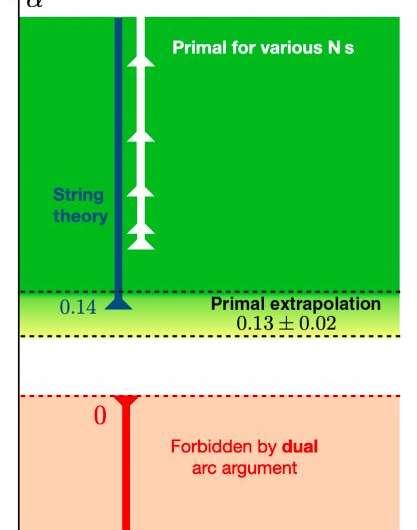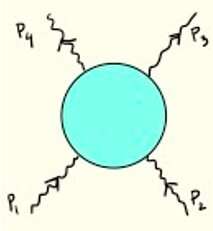September 9, 2021 feature
Researchers use the S-matrix bootstrap to examine whether string theory is the only consistent theory of quantum gravity

The S-matrix bootstrap is a numerical method that can be used to determine or constrain the scattering amplitudes of particles in quantum field theory using simple principles. Over the past few decades, some physicists have tried to use this technique to study different physics theories and phenomena.
Researchers at Tel Aviv University, École Polytechnique Fédérale de Lausanne (EPFL) and the Perimeter institute and ICTP-SAIFR have been developing the S-matrix bootstrap further and trying to apply it to different areas of physics. In a recent paper published in Physical Review Letters, the team tried to use it to investigate string theory, the renowned physics theory representing the fundamental components of the universe as one-dimensional (1D) 'strings', instead of point-like particles.
"The S-matrix bootstrap is an old idea that was popular in the 60s but lost popularity with the emergence of quantum chromodynamics to describe the strong nuclear force," Andrea Guerrieri, one of the researchers who carried out the study, told Phys.org. "The goal of the S-matrix bootstrap is to determine (or constrain) the scattering amplitudes of particles in quantum field theory using just basic principles, such as causality, special relativity and the fact that probabilities cannot be larger than 1. The novelty we brought to the topic was the proposal of a systematic numerical algorithm to implement all these principles."
While there are now a few dozens of past papers exploring physical systems using different versions of the S-matrix bootstrap, most of these works focus on massive particles. Guerrieri and his colleagues, however, were recently also able to use it to study scattering of massless particles, such as transverse fluctuations of a color flux tube in quantum chromodynamics or in massless pions.
"Once we realized that the method works for massless particles, it was clear that we should try it for gravitons, which are the mediators of the gravitational force," João Penedones, another researcher involved in the study, told Phys.org. "Subsequently, we chose to impose supersymmetry in 10 spacetime dimensions to reduce the technical hurdles of the problem."
The recent work carried out by Guerrieri, Penedones and their colleague Pedro Vieira applies to any theory of quantum gravity. In their study, however, they specifically used the S-matrix bootstrap to examine string theory and tried to determine whether it is the only consistent quantum gravity theory.
"Einstein's theory of General Relativity (GR) describes the gravitational interaction at long distances or (equivalently) low energy," Penedones said. "For example, it can be used to compute how two gravitons of large wavelength (much larger than the Planck length) scatter from each other. However, if we decrease the wavelength at some point, we cannot trust the prediction of GR. In fact, GR's prediction will give probabilities greater than 1."
To improve the reliability of GR's predictions, the theory must be corrected at short distances/wavelength or, equivalently, at high energy. This correction is typically referred to as an 'ultraviolet (UV) completion'.

"We often say that a theory of quantum gravity is a UV completion of GR," Guerrieri said. "In our recent paper, we investigated the first correction to the GR predictions in the low energy limit. This is what the parameter alpha in our paper stands for. "
String theory is a renowned theory of quantum gravity. Notably, in string theory, the alpha parameter described by the researchers can take on a specific set of values.
"In string theory, alpha is related to the tension of the fundamental string (in Planck units)," Vieira explained. "What we set out to explore in this paper was to be agnostic about what is the theory of quantum gravity which describes the real world and simply ask what values of alpha any such theory could produce."
Surprisingly, the researchers found that the alpha values that a theory of gravity describing the real world could have, according to S-matrix bootstrap numerical calculations, were the exact same values produced by string theory. While these findings could have interesting implications, their study had a couple of limitations that may affect its validity.
"The first caveat of our work is that the method we used is numerical; it used computer clusters to scan over a large set of scattering amplitudes and extrapolate to the full space of consistent scattering amplitudes," Vieira said. "This extrapolation procedure comes with some uncertainty. So, we find that alpha > 0.13 ± 0.02 with an estimated error bar. String theory would allow for any alpha > 0.1389 which is (within the error bars) beautifully right on our bound."
In future studies, the researchers hope to reduce the numerical error associated with the S-matrix bootstrap they used to determine whether the results remain unchanged. A second limitation of their study is that it used a simplified setup, as their investigation was specifically in 10 dimensions and in the presence of supersymmetry. The real world, however, is four dimensional and supersymmetry has not yet been experimentally observed in it.
"Still, we think that 10d with supersymmetry is a good starting point for such explorations," Guerrieri said. "One reason for this is that in 10d superstring theory is simplest and we have sharp predictions to compare our numerics against and a second reason is that with supersymmetry we can relate gravitons—which are tough objects to tame mathematically because of their spinning nature—to simpler supersymmetric partners which do not spin."
The main research question examined by the researchers in their recent study was whether string theory is the only consistent theory of quantum gravity. While they were unable to answer this question with certainty, their findings show that the S-matrix bootstrap could help to address it. In the future, Guerrieri, Penedones and Vieira would like to repeat their calculations without including supersymmetry and in lower spacetime dimensions.
"So far, we found that the values of alpha allowed by general principles coincide with those realized in string theory," Vieira said. "This is compatible with a positive answer to the question above but it is weak evidence. However, in principle, we can study other parameters, let's call them beta, gamma, etc., representing further sub-leading corrections to the predictions of GR at low energies. There is an infinity of them that String Theory predicts. If we can show that the allowed range of these parameters from the S-matrix Bootstrap principles also coincides with String Theory, then the evidence will be strong."
More information: Andrea Guerrieri et al, Where Is String Theory in the Space of Scattering Amplitudes?, Physical Review Letters (2021). DOI: 10.1103/PhysRevLett.127.081601
Miguel F. Paulos et al, The S-matrix bootstrap. Part I: QFT in AdS, Journal of High Energy Physics (2017). DOI: 10.1007/JHEP11(2017)133
Joan Elias Miró et al, Flux Tube S -Matrix Bootstrap, Physical Review Letters (2019). DOI: 10.1103/PhysRevLett.123.221602
Andrea L. Guerrieri et al, S-matrix bootstrap for effective field theories: massless pions, Journal of High Energy Physics (2021). DOI: 10.1007/JHEP06(2021)088
Journal information: Physical Review Letters
© 2021 Science X Network





















